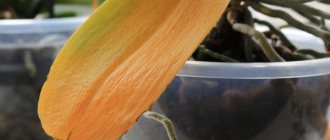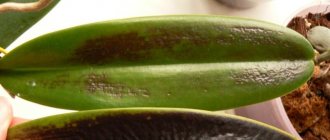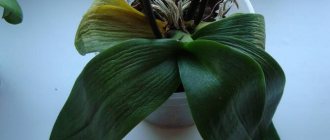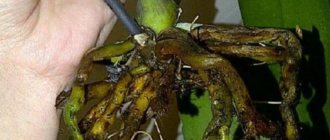Purpose of the flower arrow
After abundant and long flowering, the orchid enters a dormant state, but when the plant has accumulated enough strength, a green arrow-shaped shoot will appear. This is the peduncle, on which, with proper care, the first buds will soon appear.
After flowering has ended, you should not get rid of the green shoots. New buds or shoots may begin to form on it, making it possible to produce children.
A damaged, dried peduncle is not a final sentence . Its correct removal will allow the plant to take a break, accumulate strength and nutrients in order to give life to new green shoots and flowers.
What does a dried peduncle look like?
During the drying phase, the arrow loses its rigidity and elasticity. At this time, her appearance gradually changes: the green tone gradually fades and fades. The peduncle loses its shape and becomes purple or brown.
The drying part of the plant lacks refreshing moisture. In a dried peduncle, photosynthesis and other life processes stop. Simply put, this part of the flower fades away.
When is it abnormal?
The shoot may dry out for natural reasons , especially after flowering has ended.
Then this will be a normal reaction of the plant. But if the shoot has appeared recently, buds appear on it or flowering occurs, and the arrow begins to turn yellow and lose its appearance, then the matter requires intervention. Premature drying of the flowering shoot leads to disruption of natural processes, which can ultimately result in the death of the plant. With proper analysis of the situation, the condition of the orchid can be improved.
Main problems
If we grow babies from a peduncle, we may encounter various problems.
Does not produce a peduncle
Regular watering of the plant stimulates leaf growth, so a change in climate is necessary for the formation of a peduncle. First of all, create a period of drought:
- air temperature should not exceed 30℃;
- double the interval between waterings to achieve complete drying of the roots. After this, the orchid should stand without watering for another 4-5 days in a warm room, and up to 7 days in a cool room;
- at this time the plant is not sprayed or fed.
To stimulate the appearance of a peduncle, the orchid is subjected to drought.
The appearance of a flower-bearing arrow means the resumption of care, excluding feeding.
Children are not educated
The formation of children can be considered as an orchid’s response to unfavorable conditions. By creating a regime of poor watering against a background of high temperatures and humidity, you can achieve the development of children. If this does not help, the dormant kidney is treated with cytokinin paste.
The emerging shoot has dried up
Such a baby on the peduncle is removed. If there are other dormant buds on the peduncle, then you can try to awaken them by treating them with cytokinin paste, and then create the conditions necessary for the plant to develop.
The dried baby must be removed.
The roots of a young plant died
To stimulate the re-development of roots, a special technique is used using sphagnum moss, thread and film for food products:
- the moss is soaked in water until it swells;
- form a ball out of it, fastening it with thread;
- the resulting lump is attached with a thread under the base of the baby;
- every day the ball of moss is sprinkled with water, to which it is recommended to add “Kornevin” to stimulate root growth.
Attention! An orchid with moss tied to a peduncle may topple, so it is better to tie it to a support.
Usually, the roots of a child are formed within six months, after which the small plant is ready for replanting.
Why can the arrow dry out completely?
The main reasons for the deterioration of the health of the flowering stem of an orchid:
- insufficient amount of light;
- excess mineral fertilizers;
- lack of nutrients;
- dry or too humid air;
- change in room temperature to an unacceptable level;
- the presence of unfavorable, stressful factors.
The following is a detailed look at what causes a flower shoot to dry out:
- Orchids are found naturally in exotic countries with tropical climates.
A prime example is Thailand, where you can find many varieties of this beautiful flower. Therefore, orchids prefer warmth, sufficient light, and moderate air humidity. In winter, daylight hours in our country are noticeably reduced, which negatively affects flowers. - Orchids do not tolerate the scorching, hot rays of the sun, but they also do not tolerate the absence of light well, so try to install the plant in a sufficiently lit place that can be protected with a special film from direct sunlight.
- Fertilizers should be used only when necessary, without deviating from the instructions in the instructions, observing the norm and dosage.
- With excessive humidity, the process of rotting is possible, but with dry air, shoots, flowers, and leaves begin to wither before our eyes.
- You can encounter hypothermia when transporting the plant during cold periods and when the room is heavily ventilated.
Monitor the temperature in rooms where there are plants. - Stressful situations are associated with a sharp change in the conditions of keeping orchids at home. This could be an incorrect or untimely transplant, a change of location or owner.
Re-blooming - is it possible?
The answer largely depends on what species the orchid belongs to. For example, if we are talking about dendrobiums, the flowering times for different varieties of this species are also different. On average, such an orchid blooms for 2-6 months. An exception in the orchid world is phalaenopsis, which can bloom almost all year round.
In order for the plant to produce more buds, a number of conditions must be met. Firstly, the peduncle must be completely healthy, not shriveled or diseased. The age of the flower also matters. Only mature orchids that have already reached adulthood are capable of re-blooming. Such a plant has at least 5 shoots, and more often 7-8.
Stimulation of flowering
If the orchid is completely healthy and at the right age, you can try to encourage it to bloom again. To do this, it is necessary to provide the plant with ample lighting. If there is not enough light in the room, take care of artificial lighting.
Experienced flower growers know that slight stressful conditions sometimes activate an orchid to bloom again better than all other methods. To create such stress, you can reduce watering for a while and lower the air temperature in the room. Often such seemingly negative changes lead to the plant producing new flower buds.
When you see that the measures taken are bringing results and the flower buds of the plant have begun to swell, place a small container of water next to the orchid to moisten it. If this happens in winter, it is recommended to spray the flower additionally.
To stimulate flowering, you need to remember about fertilizing. It is known that an excess of nitrogen has a bad effect on flowering, activating only the rapid growth of green mass.
What to do: step-by-step instructions
If the appearance of the plant does not leave much to be desired, then you should clearly analyze the conditions under which the flower is kept and take the necessary measures to stabilize the situation.
Is it worth pruning?
It is not recommended to cut a shoot that has just begun to turn yellow; wait until the sprout dries out. In this state, it will be easier to remove wilted shoots, minimally damaging the plants.
Experts and flower lovers with extensive experience recommend cutting off any shoots during the plant's hibernation period . For orchids this is the fall-winter season.
We invite you to watch a video on how to trim an orchid peduncle:
Do I need to replant?
Replant the plant at the first sign of suspected root damage, rot, or change in color of the root system.
When performing the procedure of replanting a plant, it is recommended to follow simple rules:
- carefully try to remove the plant from the pot without damaging the shoots;
- run the root system under running water at room temperature to clean them;
- if there are rotten areas or diseases, cut off the affected areas, treat them, and let them dry;
- prepare a new pot, soil mixture, drainage;
- complete the replanting process, then isolate the plant for a while, do not water it with a stream, carry out regular spraying and moistening.
Actions with dried shoots
- If the shoots turn yellow, remove only those parts that have turned yellow. When the flowering shoot dries out, it is better to remove it completely.
- After cutting off the dry parts, you should place the plant in a dormant state, limit or stop watering for a while.
Interesting ideas and tips for orchids
An orchid is an epiphytic plant; when transplanted, you can imitate natural conditions and grow the plant not in a pot, but on a wooden lattice or bars. Pine bark is used for this.
Having built a support for them with boiled pine bark, tie the plant to the structure and let the orchid itself take root in the new place. For the success of the event, high humidity in the room will be a necessary condition. With this planting, the plant requires the same care as when growing in a pot.
Some types of orchids, whose main feature is leaves, grow wonderfully in aquariums, vases and other glass containers, such species include Gemaria, Anectochilus, Makodes. The main condition for the existence of an epiphyte in a glass container is high humidity.
When moving a tropical beauty to a new place, remember that the flower will take some time to get used to the new place and re-blooming may be delayed. The orchid has faded, what to do next is your choice. Remember, a flower constantly needs care and attention, and inattention can have a detrimental effect on the condition of the plant.
Plant care
After the procedure for removing bad shoots, you should take care of the orchid, keeping in mind the following:
- adjust the temperature to moderate;
- exercise strict supervision over the drying out of the soil, water through a pan;
- introduce restrictions on overly dark and overly light rooms;
- humidity should not be below 50%;
- moderate ventilation is necessary, avoid drafts at all costs;
- stop using fertilizers for 3-4 weeks;
- Spray regularly.
Know that once every 2 years the orchid requires replanting, updating the soil cover, enlarging the pot if it grows well.
Remember, a dried out peduncle is only a temporary obstacle on your way to healthy and beautiful flowers on your favorite orchid. With proper removal of dried parts, their processing and care, soon new arrows will appear on the plant, ready to give life to beautiful buds .
Trimming
Is it necessary?
It all depends on how important it is for the development of the orchid . Some gardeners prefer to trim the phalaenopsis flower stalk after each flowering, regardless of whether it has dried out or not. Sometimes this is really appropriate, since a new branch appears at the site of the cut.
In this case, it is important to remember that you need to trim the dry trunk close to the growth outlet and do this exclusively with disinfected scissors or pruners.
You need to trim the peduncle as low as possible.
ATTENTION! To avoid infection of the flower, it is necessary to sprinkle the cut area with crushed cinnamon, charcoal or activated carbon.
Deadlines
It is best to prune after the orchid has bloomed . Even if, during abundant flowering, the gardener notices that the top of the peduncle has dried out, you should not immediately take up the scissors. This can create a stressful situation for the orchid, which will lead to premature flower drop. In addition, untimely pruning can cause exotic plants to stop blooming altogether.
Basic rules and nuances
In order not to harm your green darling, you need to trim the dry trunk only after the end of the flowering phase.
You need to trim as close as possible to the rosette of growth , then there is a high probability that the trunk will not be damaged and the flower will quickly release a bud or give a new arrow.
Trimming should only be done with disinfected tools . For disinfection, ethyl alcohol is needed, as well as several cotton pads. After the operation, it is recommended to sprinkle the cut areas with cinnamon or charcoal powder.
If the peduncle dries out, as well as the flowers on it, this may mean that the light or water regime is disrupted. For further normal development of the plant, the irritating factor must be removed. If the root system is hopelessly flooded, the exotic tree needs to be urgently replanted.
The first and main advice for novice orchid breeders is to be sure to trim off dry shoots that are unable to bloom. The second necessary manipulation for the birth of a baby is regular and high-quality feeding.
If the baby grows on a peduncle that has dried up, it must be urgently separated from the mother plant and replanted in a separate pot. It is important to remember that such a shoot can be fed no earlier than 1-2 months, and watered 1-2 weeks after transplantation.
The peduncle and buds on it can dry out, among other things, from excess moisture. The fact is that excess moisture, as well as its lack, dries out the root system, which contributes to the drying out of the flower as a whole.
Rooting process
After separating the shoot from the adult flower, the following steps are performed:
- Take a transparent plastic container. Drainage holes are made in its bottom to effectively remove water;
- the root system of the baby should be at the same level as the edge of the container;
- Then special soil for orchids is poured into the selected container. In this case, preference should be given to fine fraction substrate. It should contain small fragments of bark. The soil must not be compacted. Only tapping on the edges of the container is allowed.
After planting the baby, it should not be watered for the first three days. After this, watering is carried out only when the substrate dries. It is worth noting that the planted side shoot needs to be watered at least once a week. Some gardeners prefer to additionally germinate it in moist sphagnum (moss) before planting the baby in the ground. In this case, the shoot is placed in a kind of greenhouse or room with optimal humidity and temperature. When well-developed roots appear, the plant is planted in a pot.
As you can see, raising a baby on an orchid is not a very labor-intensive process. Follow the above steps correctly and everything will work out.
Types of children
Depending on the location, the following types of children are distinguished:
- basal;
- located on the peduncle;
- developed in the leaf axil or stem.
Most often, the development of shoots in phalaenopsis is observed on the peduncle. This may be due both to the creation of favorable conditions and to the approaching death of the mother plant. In most cases, they manage to develop into an independent plant without outside help.
The mechanism of development of root and stem children is somewhat different. It is not the dormant bud that participates in their formation, but the meristem tissue of the plant. Experienced gardeners associate the appearance of such shoots with the approaching death of the plant. Their appearance is also possible due to injuries to the trunk, death of a growing point, during a prolonged drought, or when a peduncle forms from the center of the rosette. Children that develop on the trunk or in the leaf axil may not produce roots for a long time, so their rooting is somewhat difficult.











